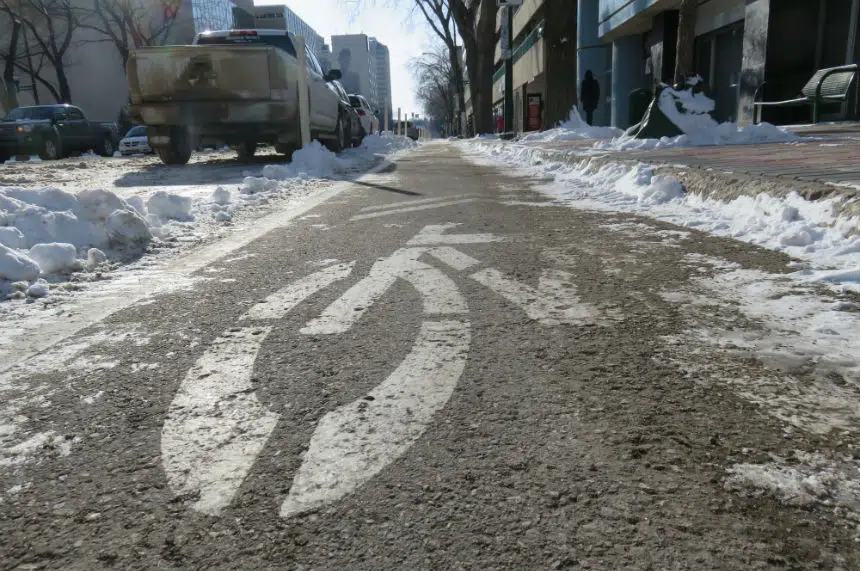Saskatoon’s downtown cycling lanes are one step closer to becoming a permanent fixture in the city’s core.
City council’s transportation committee voted 5-1 Monday to endorse a plan for the expansion of bicycle paths and sidewalks throughout Saskatoon.
The active transportation implementation plan involves moving bike lanes from Fourth Avenue to a new permanent location on Third Avenue. Current pilot project lanes on 23rd Street would also be made permanent.
Permanent bike lanes would have metal posts currently separating bicycles from cars removed in favour of curbs and drainage systems to prevent flooding.
The plan would also add more paths through the city core on 19th Street and Spadina Crescent.
The cost of the downtown lanes is estimated at $4.6 million to be spent between 2020 and 2022.
The overall cycling infrastructure plan suggests spending a total of $10.275 million over the next decade to expand an interconnected bike path system into under-served areas of the city.
Mayor Charlie Clark voted in favour of the plan along with councillors Zach Jeffries, Cynthia Block, Sarina Gersher and Bev Dubois.
Clark said the aim is to create a “better downtown” and provide more choice for people who want alternate ways to commute to work.
“The goal here is to give people — whether they walk, cycle, bus, drive — safe ways to get to work that doesn’t have pedestrians and cyclists in conflict on sidewalks, and that enables people to get around in whatever way is more convenient and affordable to them,” he said.
The mayor noted the price tag for the plan did surprise him, and said council may work on reducing the cost to taxpayers for implementation.
However, he noted the city has already spent large amounts of money on cycling infrastructure in others areas of Saskatoon without as much controversy as the downtown project.
“I haven’t heard a lot of people complain about Victoria Avenue, I haven’t heard a lot of people complaining about the multi-use pathways on McOrmond Drive,” he said.
“We need to look at it in the big picture — how do we have as much of a positive impact as possible?”
Ward 5 Councillor Randy Donauer was the only member of the committee to vote against the plan.
He expressed concern about the speed at which city staff wanted to move forward with building the bike lanes, and about how much they’d be used.
A city report stated the goal was to increase the share of people riding their bike to work to four per cent of the population, double the current two per cent.
“For the amount it’s costing, and the percentage of our residents that use it — especially in winter —- it’s a lot of money,” Donauer said.
“It’s probably a little steep for me and I would say a little out-of-step with the public feedback we got on that program.”
The veteran councillor suggested slowing down on projects close to the city core and focusing on developing bicycle-friendly infrastructure in new road developments.
The committee will receive a seperate report in April providng more financial details on the plan. Each project also still needs final approval from city council before construction starts.
IMPACT ON BUS RAPID TRANSIT
The plan to move the Fourth Avenue bike lanes to Third Avenue also hinted at a shift from city staff on where they’d like to see a future bus rapid transit (BRT) route move through downtown.
Previous work had Third Avenue pegged as the destination for the BRT system’s bus-only lanes, (https://www.ckom.com/2018/06/13/growth-plan-calls-for-more-bike-lanes-details-brt-routes/ ) which would use fewer stops to get passengers to hubs faster than regular transit.
Donauer said he hoped the bike lanes potentially moving to Third Avenue signalled administration would put the BRT along First Avenue instead.
“I’m hoping that’s a signal that we’re listening to what the business owners have been telling us.”
He said downtown businesses had been clear on their preference for the BRT route.
“The business owners on First want it, the business owners on Third don’t want it,” he said.
He added First Avenue may make more sense for BRT in the long run, with the city also considering the possibility of a downtown arena that could find its way close to that corridor.











